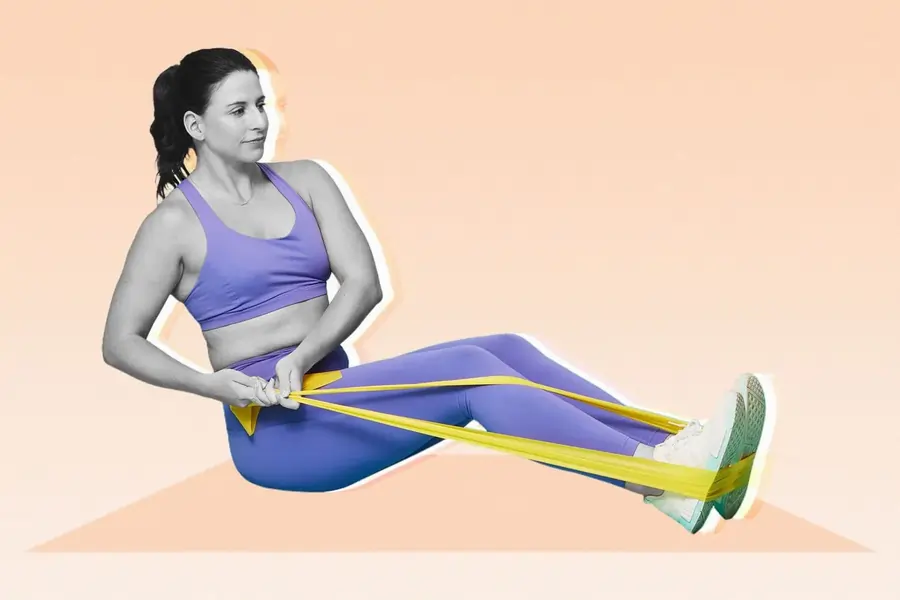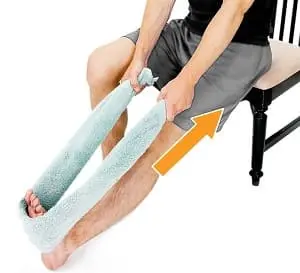13 Best Core Exercises With Bands
We’ll look at some of the top resistance band core workouts in this article. From traditional workouts with a twist of resistance to advanced band exercises, you’ll learn how to improve your core training and develop a functional, well-rounded core.
Introduction:
Resistance bands are among the most flexible and effective equipment for building your core, whether lifting them at home, the gym, or on the go. Portable and lightweight, these bands challenge your muscles in ways that bodyweight or even weights alone cannot by maintaining tension throughout every exercise. Most importantly, core workouts with bands may be readily adjusted depending on all levels of fitness, from beginner to expert.
Adding resistance bands to your core training regimen provides an engaging component that works your muscles in different ways. These multifunctional elastic bands maintain tension during each workout while engaging a few core muscle groups, including the rectus abdominis, obliques, and transverse abdominis.
Core Exercises With Bands provides a developed challenge to help you build strength, stability, and flexibility, regardless of your level of fitness experience.
Exercise Benefits:
Maintaining Pressure for Maximum Involvement
Resistance bands offer consistent resistance over the whole range of motion, in contrast to bodyweight exercises or free weights where tension might change. In order to maximize muscle activation and improve control and endurance, your core must remain active during the whole exercise. The band doesn’t slow down when you’re extending, twisting, or stabilizing, which is excellent for creating a stronger and responsive core.
Flexibility of Movement Planes
The majority of conventional ab exercises concentrate on sagittal plane exercises, such as sit-ups and crunches. You can experiment with all three planes of motion with resistance bands:
- Sagittal (forward/backward) exercises: crunches and leg raises
- Side-to-side (frontal): side planks, lateral band walks
- Transverse (rotational): sitting rotations, banded Russian twists
For healthy muscular development, which lowers the chance of injury and improves performance in sports, lifting, and daily life, this 360-degree core exercise is essential.
Improved Capability to Function
Band-based core workouts recreate a variety of athletic and real-world movements, particularly those that require twisting or rotating resistance. The deep stabilizing muscles that support your spine, protect your back, and improve your posture such as the multifidus and transverse abdominis are strengthened by this type of functional training.
For instance, exercises like the Pallof press help develop anti-rotation, which is essential for real-world power while affecting a bat, carrying groceries, or performing any other type of physical work.
Convenience and accessibility
Resistance bands have several useful benefits, including the following:
- lightweight and small
- It is portable and requires very little room to set up.
You don’t have to give up intensity or variation to train your core anywhere at home, in a hotel room, or even outside. This removes one of the primary barriers to regular training: the need for a gym or equipment.
Better for Spine and Joint Health
Compared to heavier weights, bands offer a low-impact resistance that is easier on your joints. Your shoulders, hips, and spine will experience less shock when the band expands since the tension builds gradually. This is especially important for people dealing with chronic pain or recovering from accidents.
They also promote improved control and form, which lowers the possibility of bad movement patterns that might result in injury.
Promotes Balance and Stability
Bands naturally strengthen your stabilizer muscles because they force your body to resist unwelcome movement. By improving your balance and coordination, you can feel more in control of your daily activities and lower the chance of falls or tweaks, which are essential as we age.
Easy Ways to Handle Progressive Overload
Resistance bands make progression simple because they are available in light, medium, heavy, and very heavy tension levels. Simply change the band instead of purchasing new equipment or plates. Additionally, you can raise resistance by:
- Reducing the length of the band
- Bands are being doubled up.
- Increasing the amount of time under stress
Over time, your core will be put to the test, which is essential for building muscle and increasing strength.
Improved Mind-Muscle Communication and Muscle Activation
Resistance bands improve your capacity to concentrate on the muscles you’re working by slowing down your movement and increasing your demand for stability and control. This improved mental-muscular link helps in:
- Increased use of the deep core muscles
- Increased effectiveness of workouts
- Over time, improved muscle tone
Fit for Every Level of Fitness
Resistance bands are adaptable, regardless of your level of experience with resistance training:
Light bands can be used by beginners to stabilize and strengthen their core.
Intermediates can make movements more difficult and complex.
Bands can be added to high-intensity circuits or complex exercises for advanced users.
Because of its flexibility, band-based core training is adjustable and accessible.
Excellent for Both Prehab and Rehab
As bands help restore strength and coordination without overloading healing tissues, physical therapists frequently use them in core training. Bands work particularly well for:
- After an injury, reactivating the core
- Improving regulation of the neuromuscular system
- Putting imbalances under control
Including banded core work can help avoid problems later on, even if you are not injured.
Core Exercises With Bands:
Banded dead bug
A great core stability exercise, the band dead bug can be improved by the use of resistance bands. It teaches you how to maintain a stable spine and improves the coordination of your deep core muscles, particularly the transverse abdominis, and your limbs.
- Make sure the band is fastened at a low level.
- Set on your back in a tabletop position with your feet off the ground.
- Knees bent at a 90-degree angle, and your head away from the point of fixation.
- Holding the handles or ends of the band with your arms straight out toward the ceiling will help maintain it tight.
- Drop one leg carefully to the floor, either straight or bent, being careful not to let the band pull you back.
- Hold this position for a few seconds.
- Then return to your neutral position.
- Then relax.
- Repeat these exercises 5 to 10 times.
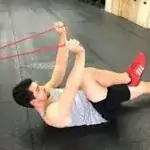
Banded plank walk
Using a band to provide lateral resistance, the banded plank walk is a powerful exercise for shoulder and core stability. Your entire core, glutes, shoulders, and scapular stabilizers are worked out, much like a side-stepping plank, especially if you add a small band.
- Straighten your wrists using a band.
- Place yourself in a high plank position.
- Step both your right foot and right hand sideways quickly.
- Then return to plank width by following with your left hand and foot.
- Continue “walking” laterally in one direction for five to ten steps, then turn around.
- Then return to your neutral position.
- Then relax.
- Repeat these exercises 5 to 10 times.
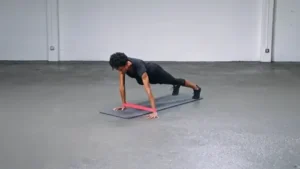
Banded bird dog
A more advanced variation of the traditional bird dog exercise, the banded bird dog adds resistance to test your shoulders, glutes, core stability, and general coordination. It’s the most common exercise for building control, particularly in athletes or anyone working on posture and spinal stability.
- To create a quadrupedal position, put your hands under your shoulders and your knees under your hips.
- One end of the band should be wrapped around the right leg.
- Use your left hand to grasp the opposite end.
- Press your left arm forward and your right leg back at once, pushing against the resistance.
- Hold this position for a few seconds.
- Maintain self-control to get back to the beginning posture.
- Then return to your neutral position.
- Then relax.
- Repeat these exercises 5 to 10 times.
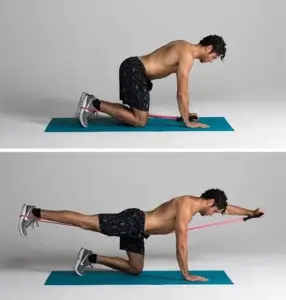
Banded bridge
A straightforward but incredibly powerful exercise for your glutes, hamstrings, and core particularly your posterior chain is the banded glute bridge.
- Having your knees bent, assume the supine position.
- Place the resistance band close to the thighs or above the knees.
- Maintain a level foot and a stabilized core.
- Put pressure on your heels and lift your hips to maintain a straight posture.
- Drop to your knees and press them up against the top band.
- At the top, firmly squeeze your glutes.
- Hold this position for a few seconds.
- Lower yourself back down slowly.
- Then return to your neutral position.
- Then relax.
- Repeat these exercises 5 to 10 times.

Banded Standing knee tuck
When you use a band to add resistance, the banded standing knee tuck is a powerful core exercise that works your entire core while targeting your hip flexors, lower abs, and balance. Along with being helpful for posture, coordination, and core strength, it can also increase your heart rate if done more intensely.
- Starting by standing up on the ground.
- Put a band around each foot.
- Your feet should be hip-width apart, and your core should remain upright.
- Raise your right knee close to your chest to build muscle in your lower abdomen.
- Throughout, maintain the band’s intensity.
- Return your leg to the ground slowly and gently.
- Then return to your neutral position.
- Then relax.
- Repeat these exercises 5 to 10 times.

Standing Pallof Press
One of the finest core workouts for preventing rotation with a resistance band is the standing Pallof press. Although it appears easy, it puts a lot of pressure on your postural control, obliques, and core stability.
- The band should be secured at chest height.
- Knees slightly bowed, come sideways to your anchoring point.
- You can grasp the band with both hands or join your fingers.
- Until the band is tight, stay away from the area.
- Keep your hands at your chest.
- Keep your body from twisting; brace your core.
- After a few moments of full extension, return yourself to your chest.
- Then return to your neutral position.
- Then relax.
- Repeat these exercises 5 to 10 times.

Banded Sit-ups
The banded sit-up is a more intense and effective way to strengthen your core since it adds resistance to the traditional sit-up. By increasing the tension throughout the exercise, particularly during the concentric phase (when you’re coming up), a band can help you get better control and stronger abs.
- A lengthy resistance band should be secured at floor level behind you.
- With both hands, grasp the band (either at chest level or stretched over your shoulders) while lying on your back with your knees bent and your feet flat.
- Maintain the band’s tension at the lowest position.
- Raise your upper body toward your knees and perform a controlled sit-up while keeping the band resistant.
- Hold this position for a few seconds.
- Then slowly lower again while maintaining control.
- Keep the pressure up continuously.
- Then return to your neutral position.
- Then relax.
- Repeat these exercises 5 to 10 times.

Banded wood chop
Your obliques, transverse abdominis, shoulders, and even hips are all worked out with the dynamic, rotating banded wood chop. It is excellent for increasing functional core strength, rotational power, and movement copying.
- For a high-to-low chop, secure the band above shoulder height; for a low-to-high chop, secure it low to the ground.
- After placing your feet with your shoulders apart, stand sideways toward your securing point.
- Take a step back and hold the band with both hands to generate pressure.
- Depending on the variety, begin with your hands close to the anchor, either high or low.
- The band should be pulled horizontally across your body, from above one shoulder to the other hip.
- Rotate your hips and body in conjunction with the small rotation of your back foot.
- Keep your arms outstretched but not locked; the core is where the movement originates.
- Have control of the return.
- Then return to your neutral position.
- Then relax.
- Repeat these exercises 5 to 10 times.
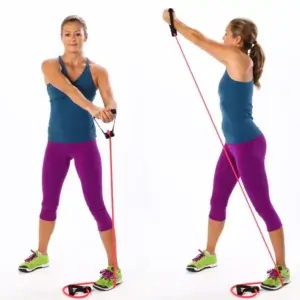
Banded Hollow body roll
- With your arms raised over your head and your legs stretched and just inches above the ground, assume a hollow body stance while lying on your back.
- Depending on the variant, loop the band around your feet for leg pressure or across your wrists for arm tension.
- Keep your body hollow by using your core; visualize a banana curve.
- Without altering your shape, start rolling sideways in one direction, either to your left or right.
- Throughout, keep the band tight since the resistance makes your body work harder to stabilize.
- Then return to your neutral position.
- Then relax.
- Repeat these exercises 5 to 10 times.

Banded Russian twist
This exercise is made more intense and functional by the band, which makes your muscles work against tension and resist rotation and return.
- Put the band on the side of your body at waist height.
- Sit on the floor with your knees bent and your heels level.
- Both hands should be used to hold the band’s free end.
- To activate your core while maintaining a straight back and an elevated chest, lean back a little.
- Rotate the band around your core while pulling it around your body at the other side of the attachment point.
- When the band tries to pull you back, resist and move in a controlled manner.
- Slowly pull yourself back to the center while keeping your core tight.
- Then return to your neutral position.
- Then relax.
- Repeat these exercises 5 to 10 times.
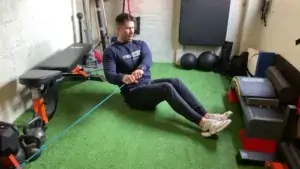
Kneeling Banded Crunch
The kneeling banded crunch is a traditional resistance band core exercise that uses bands rather than equipment to target your deep core, lower abs, and upper abs. It’s an adjustable and effective method of increasing the resistance and intensity of your core exercises with little equipment.
- Securing a resistance band high above your head, like at the height of the doorframe or overhead, is important.
- On the ground, kneel a short distance from the point of attachment.
- Pull the handles or ends of the band down in front of your shoulders or next to your head.
- Don’t sit back; instead, keep your hips planted over your knees.
- To start the crunch, brace your core and contract your abs instead of pulling with your arms.
- Maintain strain and keep the band near your head.
- Control yourself and resist the band as you slowly go back to the beginning.
- Then return to your neutral position.
- Then relax.
- Repeat these exercises 5 to 10 times.

Banded Side plank
The banded side plank transforms the traditional side plank into a more dynamic, resistance-based core exercise. Depending on the variation, the band adds resistance for hip abduction or anti-rotation.
- Put a band close to your knees around your thighs or ankles.
- Get into a side plank position.
- Keep your glutes tight and your core active.
- Raise your upper leg against the band from the plank.
- Maintain this position at the top, then carefully decrease.
- Avoid turning; instead, keep your body straight and your hips high.
- Then return to your neutral position.
- Then relax.
- Repeat these exercises 5 to 10 times.
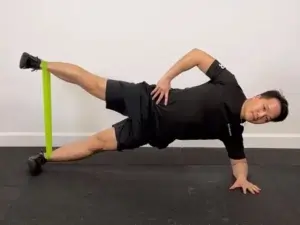
Banded Leg Raises
An improved version of the traditional leg raise, the banded leg raise targets your deep core stabilizers, hip flexors, and lower abs.
- Start with supine position on the floor.
- Wrap both feet with a loop band.
- Start by extending your legs and keeping them slightly off the ground.
- Keep your lower back down against the floor and use your core.
- Keeping your legs straight and the band taut, slowly elevate them toward the ceiling.
- Hold this position for a few seconds.
- Resisting the band’s pull, carefully lower your legs until they are simply over the ground.
- Then return to your neutral position.
- Then relax.
- Repeat these exercises 5 to 10 times.
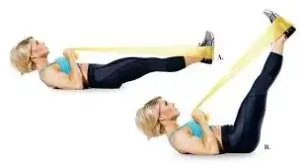
What safety measures must be followed when exercising?
Exercise safety is essential, but it’s especially important when using resistance bands, which may result in unpredictably high strain if not utilized properly. To ensure that you train effectively without being hurt, these are the essential safety precautions to take when performing core workouts with bands.
Examine the band for damage.
Before each exercise session:
- Check for holes, thinner, all of splitting, or tears in the band.
- Pay close attention to the handles and any points of attachment.
- If there are any indications of damage, replace the band right away.
The face or eyes are especially exposed to severe injuries from a snapped band rushing back.
Make Use of Correct Basis
Establishing the band to something fixed is a common practice for core exercises. Always be sure to:
- The anchor point is stable and secure; it won’t shift or fall over.
- Before beginning the entire action, you gradually test the strain.
- Make sure the door locks and closes completely before using a door anchor, and if at all possible, place the band on the joint side.
Before you start, warm up.
Avoid skipping the warm-up. A suitable warm-up
- The core is activated.
- Increases blood flow to joints and muscles.
- Improves coordination and movement.
Before starting your banded core training, try doing dynamic exercises like cat-cow stretches, jumping jacks, glute bridges, and spine twists for five to ten minutes.
Before starting your banded core training, try doing dynamic exercises like cat-cow stretches, jumping jacks, glute bridges, and spine twists for five to ten minutes.
Begin by resisting light.
Particularly if you’re unfamiliar with bands or a certain movement:
- In order to master the form, begin with a light band.
- Pay attention to control rather than speed.
- Increase resistance gradually as you gain stability and strength.
Using too much tension too quickly can cause pain in your joints or lower back and harm form.
Make Use of the Right Grip and Footing
- Verify that your feet are securely positioned or looped within the band.
- When doing tasks on the floor or while seated, use a non-slip mat.
- Unless the exercise specifically requires single-arm activity, use both hands equally to prevent uneven pulling.
You face the danger of tearing a muscle or falling if your footing changes or your grasp falls during an exercise.
Don’t let the band control you.
If you’re not paying attention, the elastic resistance might quickly pull you out of position. To be safe:
- Take your time and be mindful, especially when returning.
- Avert jerky or snapping motions.
- Maintain the band’s tension at all times; don’t let it drop suddenly.
Recognize your limits
Avoid pushing through pain. Stop if you experience:
- Acute or unexpected pain.
- The lower back is pulled in.
- Slippage of the band or sudden movement.
Over time, your body will adjust. Rushing the procedure frequently results in setbacks or overuse injuries.
Keep your balance and posture correct.
Constantly keep your core active and focus on:
- Neutral spine
- Back and shoulders down not shrugged
- When performing rotational movements or planks, keep your hips square and level.
- Taking regular breaths without holding them
Muscle imbalances or injuries, particularly in the neck or lower back, can result from improper technique during banded exercises.
Protect the Space Around You
Ensure that your training area is:
- Free of pets, mess, and dangers for trips.
- Sufficiently wide to allow the band to be safely stretched in all directions.
- Keep breakables away from you in case you fall or the band snaps back.
Stretch and cool down.
Following your core session:
- To lower your heart rate, do some gentle movement or breathing exercises.
When Should You Stop Core Exercises With Bands?
The following are the main situations in which you should stop using resistance bands for core exercises:
Sudden or Severe Pain
- Stop right once if you get any sudden, acute, or stabbing pain, especially in your neck, joints, or lower back.
- Although muscle exhaustion is common, pain is your body’s warning sign that something is wrong; don’t ignore it.
Overcoming Your Time Limit or Reps
- Take note of the repetitions, sets, or time limits you have created.
- Getting over it without the proper progression can lead to overworking or strain.
- To get stronger, your core has to relax and recover, just like any other muscular group.
Excessive Fatigue or Shaking of Muscles
- Although some shaking is normal (particularly near the end of a set), your body is telling you that it is tired and needs a break if your muscles are trembling uncontrollably or you feel unstable.
Decreased Focus or Mental Fatigue
- Your mind is also tired if you’re sleeping off, forgetting repetitions, or becoming uncoordinated.
- Focus is essential for both security and effectiveness when using resistance bands. Poor form or injury might result from mental mistakes.
Shortness of breath or lightheadedness
- Stop exercising right away and sit or lie down if you get lightheadedness, vertigo, or dyspnea.
- Dehydration, excessive exercise, or poor breathing technique (such as holding your breath while moving) may be the cause of this.
Band slips or problems with the equipment
- Stop the movement and reset if the band comes loose from its anchor, slips out of place, or breaks.
- You run the danger of getting hurt if you keep using unstable equipment.
Loss of Control or Form
- If your form begins to degrade (for example, by arching your back, unintentionally twisting, or sagging your hips in a plank), pause and take some time to breathe.
- Resistance bands need to be controlled; if you’re resisting the band rather than moving with it, you should stop or lower your resistance.
Signs of Concern From Your Lower Back
- Instead of focusing on your lower back, core exercises should work your obliques, stabilizers, and abdominal muscles.
- Stop right away and adjust your technique or switch exercises if your lumbar region starts to feel strained, pulled, or uncomfortable.
Summary:
Banded core workouts are a fun and easy way to increase strength, stability, and athletic performance. You can support a stronger, healthier body and shape your core with just a basic band and some floor space.
Resistance bands are useful tools for exercises that may be done while on a journey. They are portable and lightweight, offer enough variation to keep workouts interesting, and can offer enough resistance to increase strength and endurance.
It’s a good idea to work resistance bands into your core exercise whether you’re exercising for function, appearance, or injury prevention. Anytime, anywhere, start strengthening your core by grabbing a band and performing the previously mentioned exercises.
When done carefully and with the right equipment, band exercises are both safe and effective. By taking safety precautions carefully, you may maintain your workouts pain-free and easy while also protecting your body and speeding up your physical development.
FAQ:
Which resistance bands work best for core exercises?
Loop, flat resistance, and handle-equipped tubing bands are the best bands for core exercises. The ideal bands for rotational or anti-rotational movements are those that can be fastened to a door or other immovable object. You can gradually raise the challenge by selecting bands with progressive resistance levels.
For core training, may resistance bands be used in place of weights?
Yes, resistance bands can work just as well as or even better than weights for core exercises. Bands are safer for joints, provide continuous tension, and provide multidirectional movement, particularly during twisting or stabilizing exercises.
What is the recommended frequency of band use for core exercises?
Depending on your general regimen, you can use bands to train your core two to four times a week. Banded core exercises can be used as warm-ups, full-body workouts, or stand-alone core sessions because core muscles recover quickly.
Are core band workouts right for beginners?
Of course! Because they provide controlled resistance and are easy on joints, resistance bands are ideal for beginners. Begin with easy exercises like banded planks, sitting twists, and dead bugs that have minimal resistance.
Is it possible to burn abdominal fat with core band exercises?
Core exercises do not immediately burn belly fat, but they do tone and develop the abdominal muscles. A decrease in calorie consumption achieved via nutrition and full-body activity is the cause of fat reduction. Conversely, core exercise with bands may increase athletic performance, tighten the waist, and improve posture.
Can I work my side or oblique core using bands?
Indeed! Exercises that work the obliques and side-core muscles well include side plank rows, Pallof presses, and banded Russian twists. These exercises promote spine stability and increase rotational strength.
What separates bodyweight core workouts from band-based exercises?
Bands increase resistance, which makes strength and endurance-building activities more difficult and effective. Learning form and stability with body weight is excellent, but bands increase muscle activation, particularly in the deep core and stabilizers.
Are back pain sufferers able to safely perform core band exercises?
When performed properly, banded core exercises—particularly anti-rotational movements like the Pallof press—can be highly helpful for persons with mild to severe back problems. However, if you have back problems, always get advice from a physician or physical therapist before beginning a new program.
Can I take resistance bands on my trip?
Indeed, that is among their greatest advantages! Resistance bands are ideal for on-the-go or hotel exercises because they are small, light, and portable. When traveling, just make sure you have a door anchor or something strong to fasten them to.
References:
- Borgenicht, N. (March 28, 2023). Your entire core will be worked out with this 10-minute resistance band ab workout. Wellness. https://www.health.com/fitness/band-ab-workout techniques for resistance
- Cpt, T. C. June 25, 2021. 11 Abdominal Resistance Band Workouts to Try. Resistance band exercises for abs. Healthline. https://www.healthline.com/health/fitness
- Mateo 2024: 8 resistance band core workouts you might want to try now
- Pilon’s list of the top 10 band-based core exercises and a sample workout for 2023Gymreapers.com/blogs/news/core-exercises-with-bands This link
- Resistance band exercises for abs: https://www.prevention.com/fitness/workouts/a63496010/
- The top resistance band workouts for the core and abs in 2024 by ASP
- The URL is https://www.borntough.com/blogs/news/15-resistance-band-workouts-for-abs?srsltid=AfmBOorWin-E6LA09IRWSUAnbZD9XgqIHt2Y8LGmaYg5mcmnQt9ex80
- Image 1, Dead Bug 2.0: the most cutting-edge versions available in 2023 – Zlongdpt
- Image 2, plank walk https://fitbod.me/mini-loop-band-exercises
- Image 3, How to perform the bird dog workout by Maguire in 2025
- Image 5, Standing knee tuck with banding – 2019 – CHAARG
- Image 6, How to Perform the 2020 Pallof Press by Harris-Fry
- Image 7, 11 Pull-Up bar resistance band workouts for core, back, and arm strength – 2024 – Tesařová
- Image 8, Simple Resistance-Band Workouts by Fuhr (2015)
- Image 9, André Houdet, “Banded Hollow Hold” (2018)
- Image 10, The top ten core workouts you can perform at home without any special equipment! 2025 – Mobile Physio
- Image 11, Bodylastics USA’s Best Resistance Band Sets & Exercises for 2017 – Reagan
- Image 12, Banded side plank side kick — 2022 song by “Rehab Hero”
- Image 13, STRONG Fitness Magazine ®: 6 Resistance Band Workouts for a Complete Body Workout – 2017 – Fitness, Fitness

